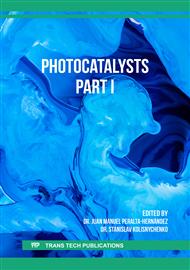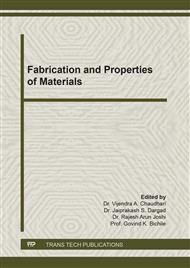[1]
Kolhatkar, A.G., et al., Tuning the magnetic properties of nanoparticles. International journal of molecular sciences, 2013. 14(8): pp.15977-16009.
DOI: 10.3390/ijms140815977
Google Scholar
[2]
Zate, M., et al., Ferrite nanostructures: synthesis methods. Spinel Ferrite Nanostructures for Energy Storage Devices, 2020: p.13.
DOI: 10.1016/b978-0-12-819237-5.00002-x
Google Scholar
[3]
Rocha-Santos, T.A., Sensors and biosensors based on magnetic nanoparticles. TrAC Trends in Analytical Chemistry, 2014. 62: pp.28-36.
DOI: 10.1016/j.trac.2014.06.016
Google Scholar
[4]
Shinde, N.C., N.J. Keskar, and P.D. Argade, Nanoparticles: Advances in drug delivery systems. Res. J. Pharm. Biol. Chem. Sci, 2012. 3: pp.922-929.
Google Scholar
[5]
Somvanshi, S.B., et al., Hydrophobic to hydrophilic surface transformation of nano-scale zinc ferrite via oleic acid coating: magnetic hyperthermia study towards biomedical applications. Ceramics International, 2020. 46(6): pp.7642-7653.
DOI: 10.1016/j.ceramint.2019.11.265
Google Scholar
[6]
Reddy, D.H.K. and Y.-S. Yun, Spinel ferrite magnetic adsorbents: alternative future materials for water purification? Coordination Chemistry Reviews, 2016. 315: pp.90-111.
DOI: 10.1016/j.ccr.2016.01.012
Google Scholar
[7]
Jadhav, S.A., et al., Magneto-structural and photocatalytic behavior of mixed Ni–Zn nano-spinel ferrites: visible light-enabled active photodegradation of rhodamine B. Journal of Materials Science: Materials in Electronics, 2020. 31: pp.11352-11365.
DOI: 10.1007/s10854-020-03684-1
Google Scholar
[8]
Akpor, O.B., G.O. Ohiobor, and D. Olaolu, Heavy metal pollutants in wastewater effluents: sources, effects and remediation. Advances in Bioscience and Bioengineering, 2014. 2(4): pp.37-43.
DOI: 10.11648/j.abb.20140204.11
Google Scholar
[9]
Jadhav, S.A., et al., Visible Light Photocatalytic Activity of Magnetically Diluted Ni-Zn Spinel Ferrite for Active Degradation of Rhodamine B. Ceramics International, (2021).
DOI: 10.1016/j.ceramint.2021.01.267
Google Scholar
[10]
Patade, S.R., et al., Impact of crystallites on enhancement of bandgap of Mn1-xZnxFe2O4 (1≥ x≥ 0) nanospinels. Chemical Physics Letters, 2020. 745: p.137240.
DOI: 10.1016/j.cplett.2020.137240
Google Scholar
[11]
Andersen, H.L., et al., Crystalline and magnetic structure–property relationship in spinel ferrite nanoparticles. Nanoscale, 2018. 10(31): pp.14902-14914.
DOI: 10.1039/c8nr01534a
Google Scholar
[12]
Humbe, A.V., et al., Impact of Jahn Teller ion on magnetic and semiconducting behaviour of Ni-Zn spinel ferrite synthesized by nitrate-citrate route. Journal of Alloys and Compounds, 2017. 691: pp.343-354.
DOI: 10.1016/j.jallcom.2016.08.199
Google Scholar
[13]
Andhare, D.D., et al., Effect of Zn doping on structural, magnetic and optical properties of cobalt ferrite nanoparticles synthesized via. Co-precipitation method. Physica B: Condensed Matter, 2020. 583: p.412051.
DOI: 10.1016/j.physb.2020.412051
Google Scholar



